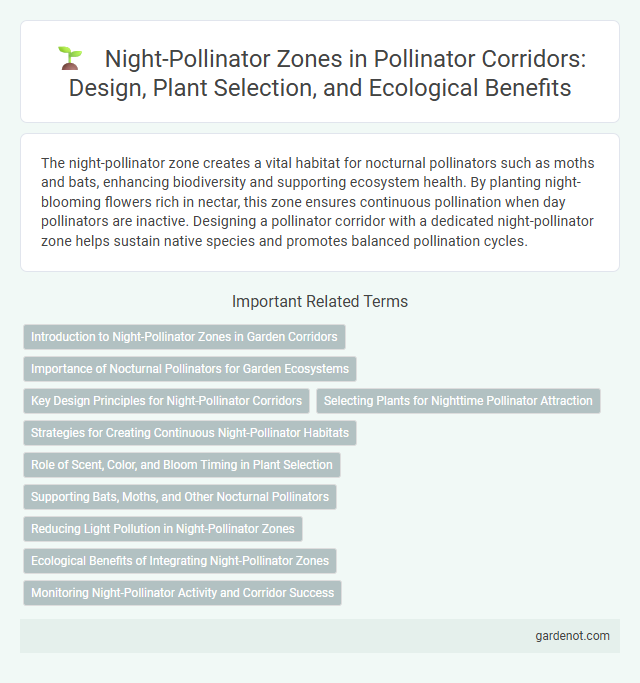The night-pollinator zone creates a vital habitat for nocturnal pollinators such as moths and bats, enhancing biodiversity and supporting ecosystem health. By planting night-blooming flowers rich in nectar, this zone ensures continuous pollination when day pollinators are inactive. Designing a pollinator corridor with a dedicated night-pollinator zone helps sustain native species and promotes balanced pollination cycles.
Introduction to Night-Pollinator Zones in Garden Corridors
Night-pollinator zones in garden corridors provide essential habitats for nocturnal pollinators such as moths, bats, and beetles, contributing to biodiversity and ecosystem health. These zones prioritize planting night-blooming flowers like evening primrose and jasmine, which emit strong fragrances and nectar at dusk to attract night pollinators. Integrating low-light environments and reducing artificial lighting in these corridors enhances pollinator activity and supports plant reproduction after dark.
Importance of Nocturnal Pollinators for Garden Ecosystems
Nocturnal pollinators like moths, bats, and certain beetles play a crucial role in maintaining biodiversity and ensuring pollination of night-blooming plants within garden ecosystems. These pollinators contribute to the reproductive success of flora that rely on nighttime activity, supporting overall plant health and fruit production. Establishing a night-pollinator zone within a pollinator corridor enhances ecosystem resilience by promoting continuous pollination cycles beyond daylight hours.
Key Design Principles for Night-Pollinator Corridors
Night-pollinator corridors prioritize low-light pollution using amber or red LED lighting to minimize disruption to nocturnal insects. Incorporating native night-blooming plants such as evening primrose and moonflowers increases nectar availability crucial for moths and bats. Structural elements like dense shrubs and layered vegetation create safe navigation pathways and shelter, enhancing corridor efficacy for night-active pollinators.
Selecting Plants for Nighttime Pollinator Attraction
Selecting plants for a night-pollinator zone involves choosing species that emit strong, sweet fragrances and display pale or white flowers to enhance visibility in low light. Night-blooming plants such as evening primrose, moonflower, and night-blooming jasmine attract moths, bats, and other nocturnal pollinators essential for ecosystem health. Incorporating these specific plants creates an effective habitat that supports nighttime pollination and biodiversity.
Strategies for Creating Continuous Night-Pollinator Habitats
Establishing continuous night-pollinator habitats involves planting native night-blooming flora such as moonflowers and evening primroses that attract moths and bats, key nocturnal pollinators. Implementing low-impact lighting strategies, like red or amber LEDs, minimizes light pollution, preserving natural nocturnal behaviors. Connecting fragmented habitats through green corridors ensures safe travel routes, enhancing pollination efficiency and biodiversity stability.
Role of Scent, Color, and Bloom Timing in Plant Selection
Night-pollinator zones rely heavily on plants with strong, sweet fragrances that attract nocturnal pollinators such as moths and bats. White or pale-colored blooms are preferred because they reflect moonlight and remain visible in low-light conditions. Selecting plants that bloom during dusk or nighttime ensures effective pollination by synchronizing with the active hours of night pollinators.
Supporting Bats, Moths, and Other Nocturnal Pollinators
Night-pollinator zones are engineered to create safe habitats for bats, moths, and other nocturnal pollinators by preserving native flowering plants that bloom after sunset. These zones minimize artificial light pollution, which disrupts the natural foraging behavior of night pollinators essential for the reproduction of many plant species. Supporting nocturnal pollinators enhances biodiversity and contributes to the stability and resilience of ecosystems reliant on night-time pollination services.
Reducing Light Pollution in Night-Pollinator Zones
Reducing light pollution in night-pollinator zones is essential for protecting nocturnal pollinators such as moths, bats, and beetles that rely on natural darkness for navigation and foraging. Implementing shielded, low-intensity LED lighting with wavelengths that minimize disruption to pollinator behavior significantly enhances their ecological function and biodiversity. Dark sky-friendly practices in pollinator corridors help maintain healthy ecosystems and improve pollination success for night-blooming plants.
Ecological Benefits of Integrating Night-Pollinator Zones
Night-pollinator zones enhance biodiversity by supporting nocturnal pollinators such as moths, bats, and beetles, which facilitate the pollination of plants that bloom exclusively at night. Integrating these zones into pollinator corridors improves ecosystem resilience and genetic diversity by ensuring continuous pollination cycles beyond daylight hours. This ecological strategy promotes plant reproduction, sustains food webs, and increases habitat connectivity for nocturnal species.
Monitoring Night-Pollinator Activity and Corridor Success
Monitoring night-pollinator activity involves tracking moths, bats, and other nocturnal species using infrared cameras and acoustic sensors to evaluate pollination rates within the corridor. Data collected helps assess the corridor's success in supporting biodiversity and flowering plant reproduction during nighttime hours. Continuous analysis informs adaptive management strategies to enhance habitat connectivity and ensure effective pollinator movement.
Night-pollinator zone Infographic

 gardenot.com
gardenot.com